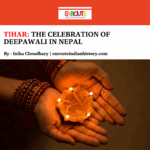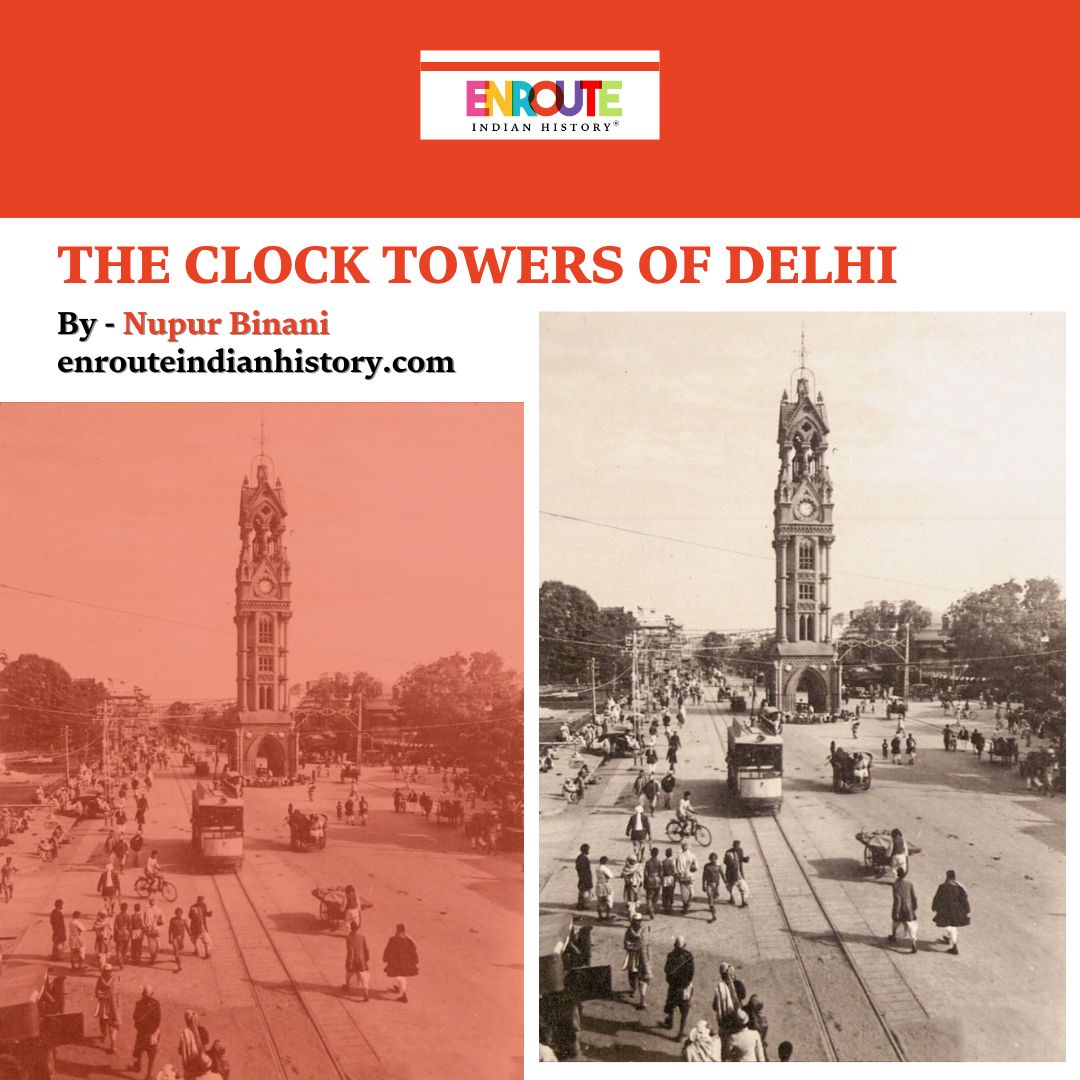
The capital city, Delhi has various historical landmarks embedded in the rich culture of Indian heritage. While exploring Delhi, one must have heard of Ghantaghar- these underrated junctions are the biggest source to understand Delhi’s history. The clock towers are huge building complexes with a large clock attached on top, its use was not just restricted to updating one about time but serves as a living heritage for centuries. Delhi has a number of Clock towers, the article explores from the famous tower to the underrated one emphasing on its history and relevance for today.
In the animated film The Clock Tower made by Cara Antonelli, a beautiful ballerina is cursed by a witch and imprisoned on the top floor of a clock tower in the centre of a panoramic village. To keep the clocks working, the belle is kept under a spell to perpetually spin on her toes to wind the gears and sprockets of the clock. Round and round she goes, day and night to keep the arms of the clock ticking and its bells chiming hour after hour. From the clock tower window the girl can see the beautiful town spread around with colourful balloons flying in the air. One day she decides to step out and see the town. As she stops dancing, the clocks stop. On stepping out, she notices that the town has changed. It is a colourless ghost town and everything in it is the shade of grey or black, and not what she had seen from the tower. With no one around, the town was eerily silent. Disappointed, the little girl walks back to the tower. On the way, as she touches a balloon string, she notices that the balloon turns crimson on her touch. When she touches a burnt plant, colourful flowers bloom on it. She realises that to bring life back to the town she must keep the clocks working. The young ballerina is heartbroken and goes back into the tower to resume her dance and watches the town come back to life. Watching this heartbreaking fairytale, one wonders if clock towers were ever the life centre of a town in the times gone by and how these towers came to occupy the central place in a town and literally achieved such heights. Time personifies life. A dead clock is a bad omen; it means stagnation, end-of-life force, and death.

The Sanskrit meaning of time refers to “kaal” who is considered the incarnation of Shiva which highlights death, as time personifies annihilation of everything that is or was. The Hindi word ghadi, ghari or ghuree which we refer to as a watch or clock, is actually a measure or unit of time. A ghari by the ancient Indian system of timekeeping was of 24 minutes. By that measure, there are 60 gharis in a day and night.Through, the biography- Baburnama, we extract the first Mughal emperor Babur employed a timekeeper called ghadiyali, who sounds a large brass plate bell hanging at a high place in the centre of the town to mark each pahar of the day. The ghariyalli’s used a water timepiece, a clepsydra, to measure and announce a ghari. As pages unfold, an historical mark was marked by construction of Clock towers throughout the country which is a tower, typically forming part of a church or civic building, with a large clock at the top. These are localised called “ghantaghar”, while travelling you must have found yourself, at least once, giving or taking directions on the basis of famous landmarks. Did they ever happen to be a ghanta ghar? That’s a clock tower for you. These clock towers are so huge in size that they form major landmarks. Ghanta-Ghar has been considered a marked distinction of British Architecture indicating a symbolic centrality of imperial administration and reflecting the cultural, religious and political acumen of the imperial mind in the town planning of an administrative centre. This symbolic erection has been used as means of expressing wealth, power, manifestation of authority and influence of empire. The British introduced a new style of architecture in South Asia with a blend of indigenous architectural designs, styles, structures, and meaning. This architecture can be found elevated on the railway stations, military cantonments, educational institutions, courts’ establishment, churches, bridges, and museums. In the British colonial era, especially the representative buildings, designed in the Indo-European style, consisting of a mixture of European and Indo-Islamic components.
As we will take a tour through Delhi, you will witness a number of Ghantaghar. Coincidentally, the oldest Clock in tower was built in Shahjahanabad- the heart of capital city, Delhi.
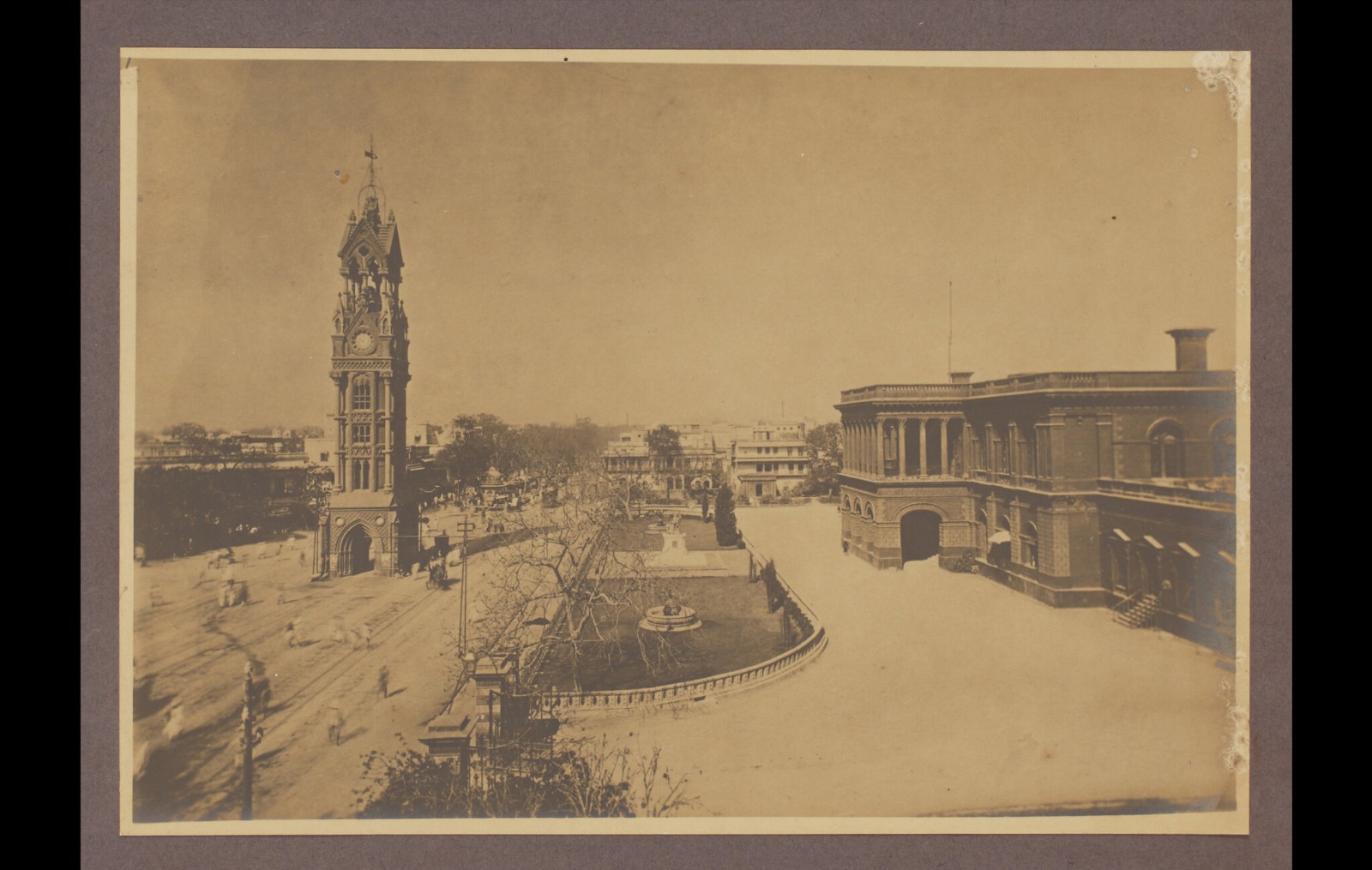
In the bustling heart of Chandni Chowk, amidst the cacophony of vendors and the vibrant tapestry of Indian life, once stood a silent sentinel- the Northbrook Clock Tower. Erected around 1870, this 128-foot-tall Gothic structure, named after Viceroy Lord Northbrook. It served as a symbol of British authority and a beacon of punctuality in a city known for its timeless charm. During its heyday, the clock tower’s four faces kept Chandni Chowk on schedule, its chimes echoing through the narrow lanes and bustling markets. Sadly, in the 1950s, the upper portion of the tower crumbled, posing a safety hazard. The decision was made to dismantle it, leaving behind only a memory and a testament to the layered history of Chandni Chowk. A localite shares her experience of the clock tower era. An interview by Medium.com mentioned a memory shared by a tour guide of chandni chowk. Once, there was an English clock tower here, and trams used to pass nearby. This was where my sweetheart Shagufta and I met each other. Whenever the clock struck 6 in the evening, Shagufta, wearing a bright-coloured kurta with a white sharara and a glittering contrast dupatta covering her head, would wait for me. We would sit on the opposite side near the town hall, watching locals selling sweets and snacks. We enjoyed kebabs together and sometimes saw the Gora sahibs in their Austin Morris cars.As the evening progressed, at 7 pm, we heard the gurgling sound of the whistling Punjab mail at the back of Old Delhi Railway Station. As is evident from the available photographs, the Clock Tower in Chandni Chowk was a delicately placed and sculpted tower. Its ornamental features were reflective of Romanesque or Renaissance buildings, having adapted features of and been influenced by Islamic architecture around it. Its pointed arches, spires and fluted pillars must have been a delight for those who watched it from the thoroughfare around it. One wonders why it was not restored, repaired and saved. It was an important landmark opposite the famous Town Hall which was the seat of local governance.
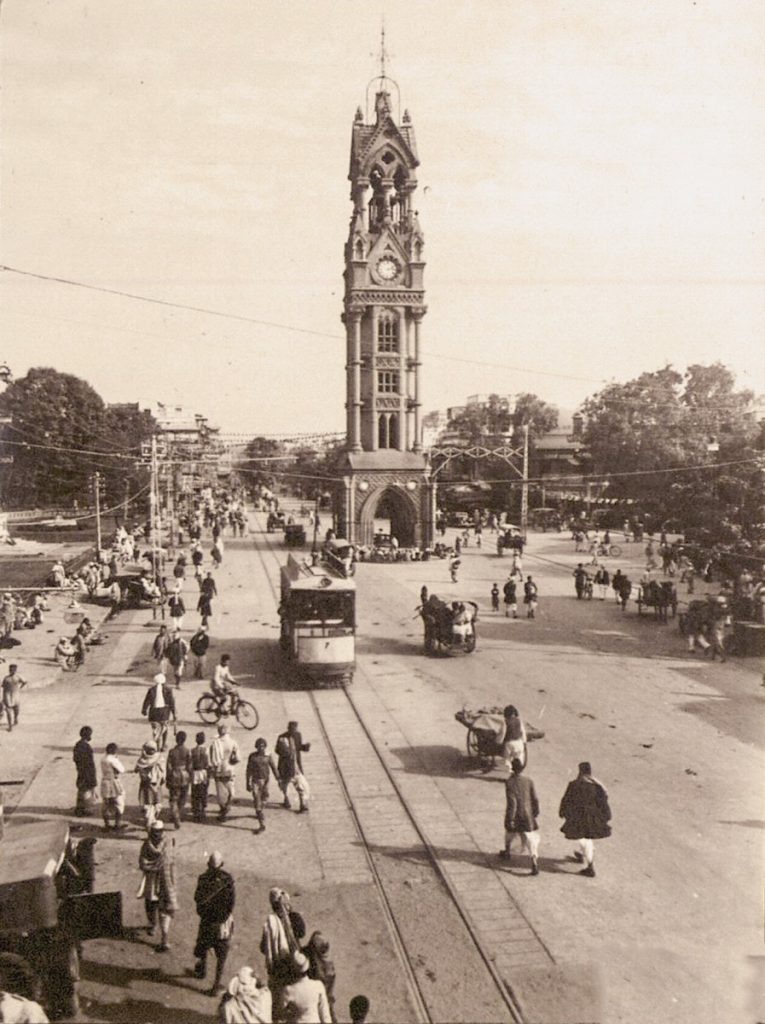
Around the time when this popular landmark called Ghanta Ghar in Chandni Chowk partially collapsed in 1950, as if to compensate for its loss, another Clock Tower with a new settlement called Hari Nagar was coming up in west Delhi. The Hari Nagar Clock Tower is a newer installation compared to some others of ilk such as the one in Chandni Chowk that was damaged in an earthquake and was never rebuilt again. It is believed that this tower was built around 1950 in the memory of Diwan Hari Singh, who was a prominent personality from the area. The original clockwork and other equipment were imported from England as the builders wanted it to display time with utmost accuracy. But later on, when the original parts gave in, they were replaced by the ones from the Hyderabad factories. The tower displays the classical structure of a clock tower with gradually smaller diameter at each stage leading to a pointed top. Some of the round holes at the top are now empty but they must have had clocks displaying time initially, located at the centre of a busy town square encircled by roads on all sides. The small area allotted to the tower in the middle also shelters some pigeons and local people are often seen feeding them. The west Delhi landmark looks simple. Just a traffic roundabout with a clock tower in the centre. But then the very many establishments that ring the circle start making their presence felt one by one. Each of them, big and small, appears to singularly contain the unique essence of the Ghantaghar. Together they make the Ghantaghar look vastly huger than it truly is. Indeed. Reading aloud these place-names is intensely evocative of that section in Iliad in which Homer famously catalogues the ships and warriors of the Achaean army. The missing time machines are an indicator of how poor we are in maintaining our city heritage. The clock on the fourth side, covered with a protective iron grill, has frozen arms. When did the clock or the time stop, no one knows. A wooden ladder has been left on the first terrace in full public view, possibly suggesting that the repair guys are squatting somewhere and repairing the clocks.
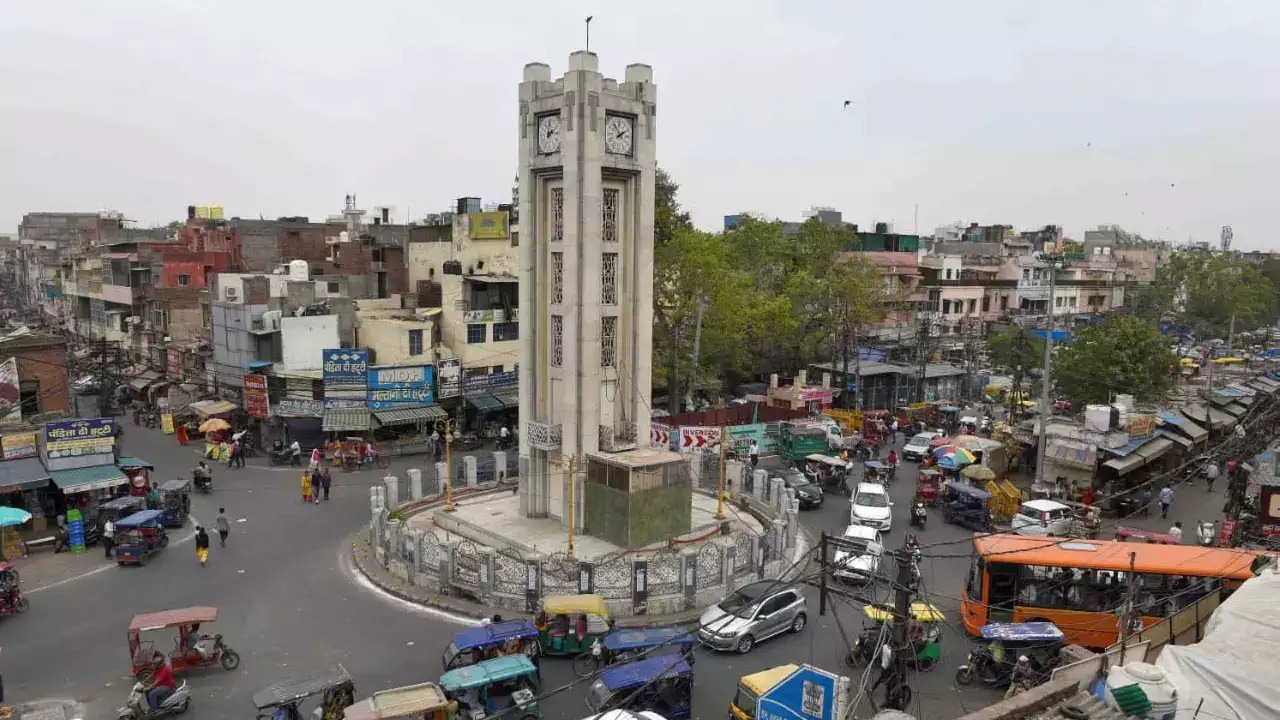
The Sabzi Mandi Ghanta Ghar, is about 1.5 km away from the then popular wholesale vegetable market and its companion building known as Baraf Khana or the Ice Factory at the junction of Roshanara Road and Patharwali gali. The wholesale vegetable market called the Sabzi Mandi has since moved to Azadpur in north Delhi.The Sabzi Mandi Ghanta Ghar was built in 1941, in the memory of a freedom fighter, a local leader and social worker Ram Swarup. Its location is very close to Delhi University and the popular and busy shopping area of Kamla Nagar. This clock tower also has a connection to another daughter of Shah Jahan, Princess Roshan Aara as one of the roads from this tower leads to the famous garden known as Roshan Aara Park. A plate hanging on the fence around the tower states its official name as ‘Ramrup Tower’ while the inauguration stone calls it ‘Ram Roop Tower’, it is assumed the family of Ram Roop had helped in development of the city. The clocks are nearly 3 to 4 diameter in size, with its exterior well maintained and 2 of the clocks show the correct time. A localite describes his experience of the historical era; A very busy route starting from Ajhudhya Textile Mills on GT Road all the way to Tis Hazari Courts, had rides of electric trams that operated in the area from Rana Pratap Bagh to Subzi Mandi. This stretch, till late 1960s, had many large industrial units like the Birla Mill and was the hub for traders who had moved into India after the Partition. Amba picture hall was a popular haunt for cinema lovers in this part of the town and students of Delhi University, now popularly called North Campus. With the days of single screen theatres being over, the Amba cinema sits glum awaiting a new avatar.
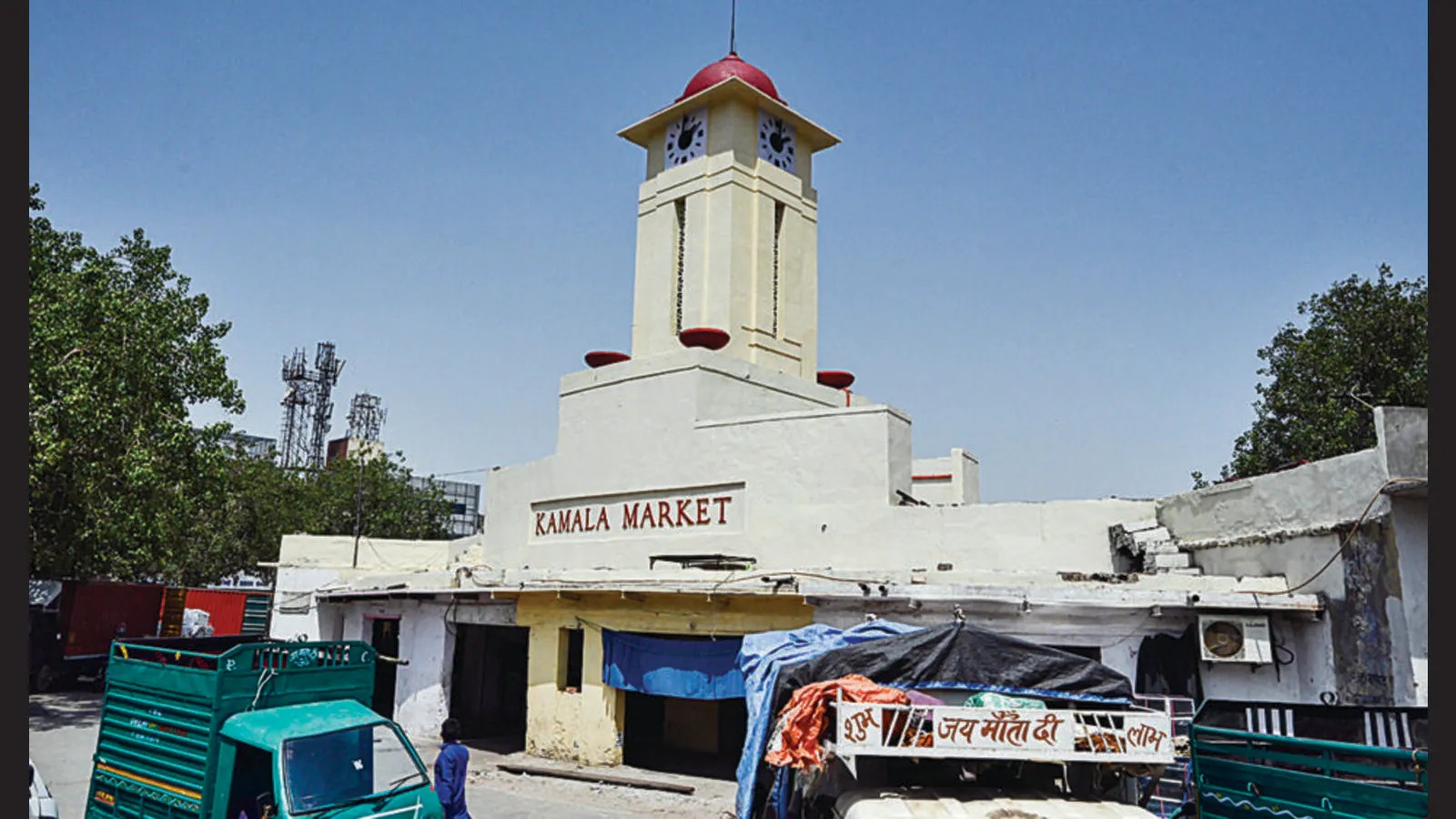
Of these famous clock towers, we have an underrated clock tower- The Kamla Nagar Clock Tower, the one that was added on top of the entry gate to Kamla Market in the Ajmeri Gate area next to Asaf Ali Road and just outside the wall of Shahjahanabad. Built in 1951, both the gate and the tower atop it are currently in bad shape and need immediate attention before they collapse or fall apart. Though all four clocks are working, they show different times in different directions. A recently published article on June 10, 2024 stated “Gong! Restored 72-year-old Kamla market clock tower starts ticking again”. The market was set up to provide livelihood to Partition refugees who settled in Delhi, and was inaugurated by former president
Dr Rajendra Prasad on November 26, 1951. The same year the clock tower was also installed there. Officials added that the larger project to restore the crumbling structures in the market is still in progress. Lakhwir Singh, vice president of the Kamla market traders association, whose family has been running a shop there since 1960, said the clock tower was maintained by the market association till 1995. Then, the local mechanic who used to maintain the clock passed away. “It has remained non-functional for almost three decades but its original machine is intact. We are glad that the heritage has been restored,” Singh said.
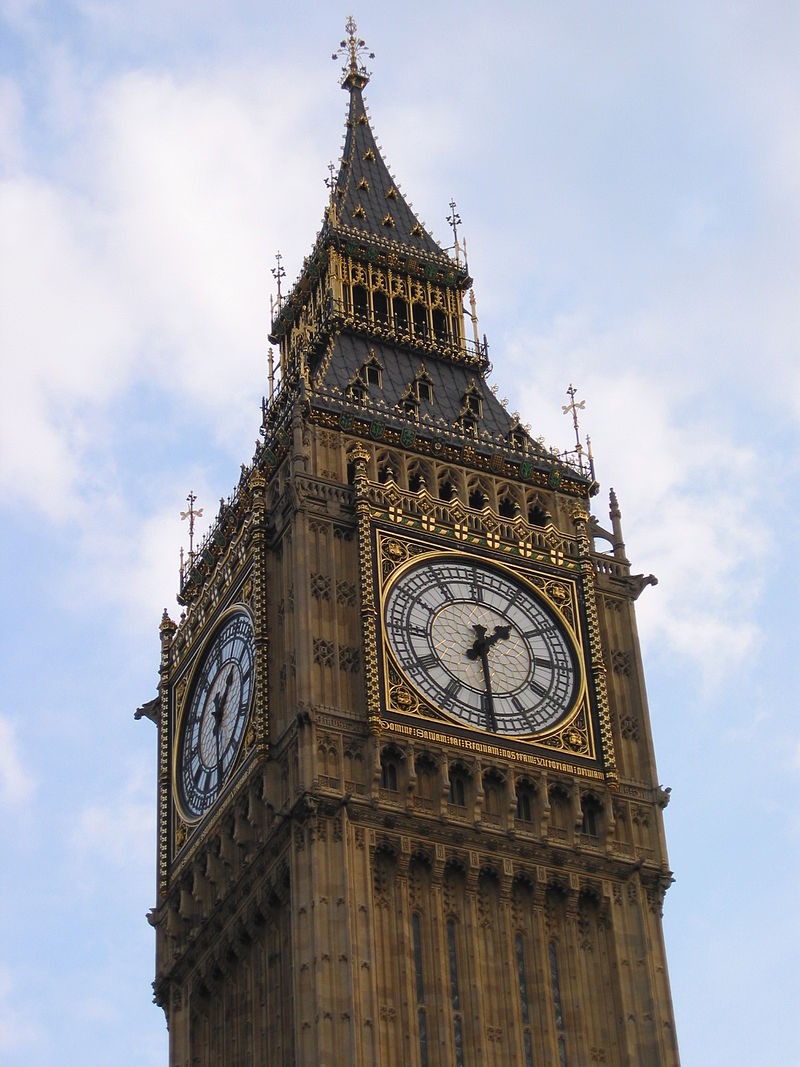
Today, our phones serve as all-in-one devices, providing everything from time to calculations. However, centuries ago, people relied on large clock structures scattered throughout cities to keep track of time, as personal watches were not yet in use. These clock towers are not just a source for ‘time’ but serve as testimony of our lost stories, hidden past and unknown history.
Between the 11th and 20th centuries, hundreds of clock towers came up in cities across the world. Located in the centre of the town or next to a church, their purpose was to remind people of the prayer times. The clock towers preceded the Bell Towers which were used both in Europe and the Americas as a way to call the faithful to prayers, summon people to organised work like a factory or railroad, to inform people of an emergency, a death or to make official announcements related to the public at large. A clock tower with its four faces showing the time created the same advantage that sound had. Just as the sound reaches irrespective of which way you may be looking, people didn’t have to turn in a particular direction to check the time.
References-:
- Prof. (Dr.) Neelum Naz. Historical Perspective on Clock towers.
- Abdul Basit.Muhammad Shafique (CA).Northbrook Clock Tower and Ripon Hall: History and Architecture of Ghanta-Ghar Multan, Pakistan
- The Wire.India’s clock tells more than a time. They tell a story
- Time travel. India’s Famous clock towers
- The hindustan times. Delhiwaale: The ghantaghar encyclopaedia.
- The hindustan times. Restoration of Clock towers
- Ancient Indian timekeeping monuments
- Chandni Chowk clock tower story
- Civilization and clock towers in India
- Clock towers in Delhi history
- Delhi clock towers and modernity
- Delhi’s clock towers modernity and heritage
- Hari Nagar clock tower architecture
- Historical landmarks of Delhi clock towers
- Kamla Nagar clock tower heritage
- Northbrook clock tower significance




